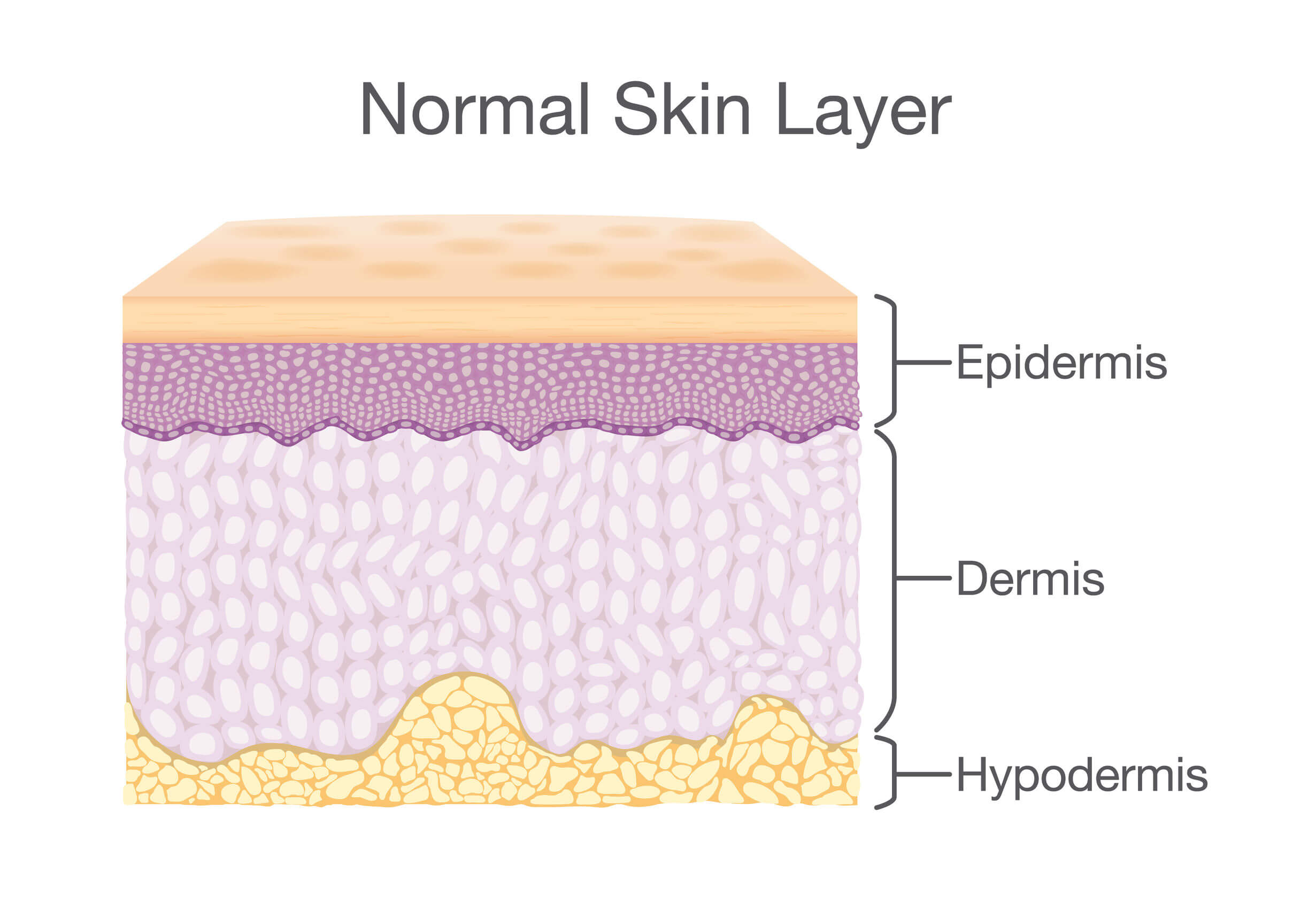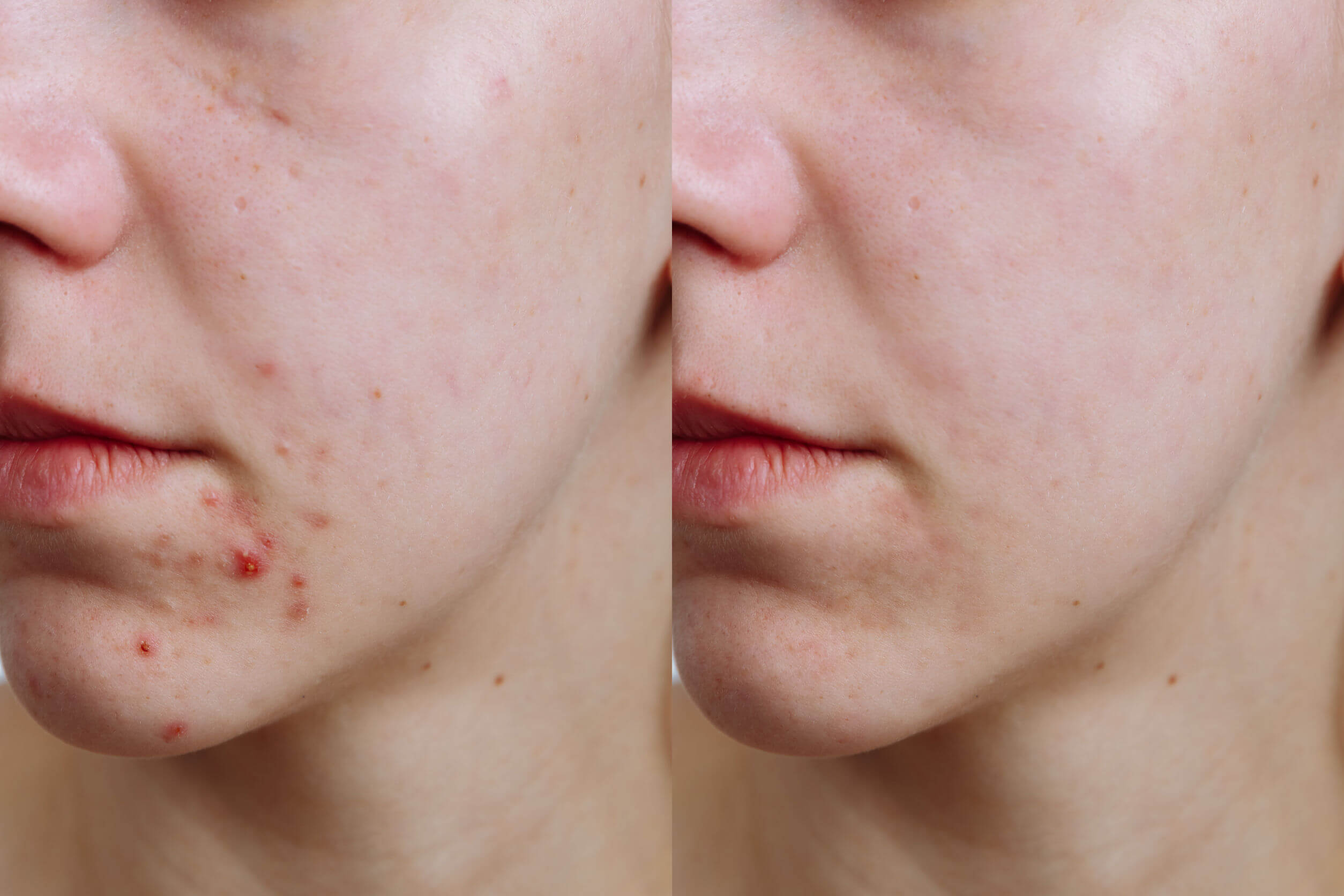5 Effects of Weather on the Skin

The effects of the weather on the skin are frequent and, for the most part, preventable. Although they’re not usually life-threatening, uncomfortable symptoms may appear over time that compromise physical and mental health.
To raise awareness about the issue, we have prepared the following article about some of the negative consequences that prolonged exposure to certain environments could have. Keep reading!
Anatomy and physiology of the skin

The skin is the human body’s largest organ, fulfilling protective and thermoregulatory functions. From a structural point of view, it’s divided into three well-defined layers: epidermis, dermis, and hypodermis.
The epidermis is the one in contact with the outside, and, depending on the area, it can be made up of 4 or 5 layers of keratinocytes. The latter term is used to define cells capable of producing keratin, a vital protein for the skin.
Keratinocytes rise from the deepest part of the epidermis as they develop, and so in the most superficial part (the stratum corneum) the cells tend to die, leaving a dense layer of keratin.
In the dermis and hypodermis, there are abundant blood vessels and cells of the immune system, which is why reactions aimed at protecting against foreign microorganisms take place here.
Due to its location, the skin is usually the first organ to be affected by adverse environmental conditions, such as excess heat or cold.
The effects of weather on the skin
Constant exposure to heat, cold, and sunlight can have severe consequences on the skin. Most of them occur after constant exposure, the exception being some cases of allergic reactions. Below you’ll find 5 representative examples (both aesthetic and pathological).
1. Thermal aging
This term is used in dermatology to refer to the premature appearance of signs of skin aging in patients with constant exposure to high temperatures. This usually appears at temperatures over 40ºC, which is why it’s frequent in the summer months.
The frequency of these symptoms may increase in some workers who are more exposed to high temperatures, such as cooks, farmers, blacksmiths, miners, and those who work in glass or rubber factories.
Thermal aging is the consequence of inflammatory phenomena in the tissue, including the formation of free radicals. These substances are characterized by generating oxidative stress, a mechanism responsible for the appearance of multiple chronic diseases. For this reason, the consumption of foods rich in antioxidants could be beneficial.
2. Dryness and flaking
According to this scientific review article (2008), from 10 to 15% of the content of the stratum corneum is made up of water. In fact, to maintain this state of hydration, cells are capable of secreting substances such as natural moisturizing factors. Dehydration can lead to flaking and dry skin.
This dehydration is part of the effects of the weather on the skin, in the case of hot environments. This can worsen if oral hydration isn’t carried out correctly, and, in these cases, the use of emollient substances may be advisable.
These symptoms can also occur after constant exposure to cold environments. In this situation, some patients develop dermatitis, an inflammatory phenomenon of the most superficial layers of the skin.
3. Rashes (urticaria)
One of the most characteristic effects of the weather on the skin is cold urticaria. Patients affected by this condition have swelling, reddened lesions, and itchy skin exposed to low temperatures.
It can appear at any stage of life, although it’s more common in young adults. From a molecular point of view, it’s known to appear as a result of reactions typical of allergic phenomena.
Therefore, the participation of mast cells, eosinophils, and basophils, in addition to the release of histamine and immunoglobulin E all contribute to producing symptoms.
In very severe cases, a systemic reaction known as anaphylaxis can occur. Here, generalized edema and airway obstruction can occur, which is why it’s considered an emergency. This usually appears after taking baths with very cold water.
4. Acne

This is a chronic and inflammatory disease of the skin, and one of the most frequent reasons for consulting a dermatologist.
According to a publication from the Mayo Clinic, it’s a consequence of the obstruction of the hair follicles and the sebaceous glands, usually when there’s excess fat or dead cells, bacterial infections, and due to the influence of testosterone.
Most of the risk factors for its onset are well identified, including age, constant friction, hormonal changes, and family history. However, the role of UV light exposure is controversial, as the results of some studies are contradictory.
According to this article (2018), this exposure causes an increase in the number of sebaceous glands and comedones. The latter are characteristic of acne, and are known by the term “blackheads.” When these areas become infected and pus production begins, lesions known as pustules appear.
5. Melanomas
This is one of the most severe effects of the weather on the skin. Melanoma is a tumor of epidermal cells rich in melanin, the main pigment on the skin’s surface.
From a clinical point of view, it can be easy to detect suspicious lesions, as they have the following characteristics:
- Asymmetry: if the lesion is divided into two almost equal halves, the appearance is different.
- Edges: these tend to be uneven and poorly defined.
- Color: the distribution isn’t homogeneous, so there may be internal areas in which the intensity of the color is greater than that of its periphery.
- Diameter: this is usually greater than 5 mm.
- Evolution: Unlike typical moles, melanomas change their size and appearance over weeks or months. In addition, symptoms such as itching, discomfort, or pain may occur.
Constant exposure to ultraviolet light is the main risk factor for the development of melanomas. This may be the result of living in regions with constant sunlight.
In order to prevent it, it’s advisable to apply sunscreen on exposed surfaces several times a day.
Protecting the skin improves physical and emotional health
Although many of the effects of weather on the skin have only cosmetic consequences, this can negatively influence a patient’s mental health.
It’s advisable to take basic measures for proper skincare, something that could be beneficial in order to avoid more dangerous pathologies. In case of doubt, it’s advisable to go to a trusted dermatologist.
The effects of the weather on the skin are frequent and, for the most part, preventable. Although they’re not usually life-threatening, uncomfortable symptoms may appear over time that compromise physical and mental health.
To raise awareness about the issue, we have prepared the following article about some of the negative consequences that prolonged exposure to certain environments could have. Keep reading!
Anatomy and physiology of the skin

The skin is the human body’s largest organ, fulfilling protective and thermoregulatory functions. From a structural point of view, it’s divided into three well-defined layers: epidermis, dermis, and hypodermis.
The epidermis is the one in contact with the outside, and, depending on the area, it can be made up of 4 or 5 layers of keratinocytes. The latter term is used to define cells capable of producing keratin, a vital protein for the skin.
Keratinocytes rise from the deepest part of the epidermis as they develop, and so in the most superficial part (the stratum corneum) the cells tend to die, leaving a dense layer of keratin.
In the dermis and hypodermis, there are abundant blood vessels and cells of the immune system, which is why reactions aimed at protecting against foreign microorganisms take place here.
Due to its location, the skin is usually the first organ to be affected by adverse environmental conditions, such as excess heat or cold.
The effects of weather on the skin
Constant exposure to heat, cold, and sunlight can have severe consequences on the skin. Most of them occur after constant exposure, the exception being some cases of allergic reactions. Below you’ll find 5 representative examples (both aesthetic and pathological).
1. Thermal aging
This term is used in dermatology to refer to the premature appearance of signs of skin aging in patients with constant exposure to high temperatures. This usually appears at temperatures over 40ºC, which is why it’s frequent in the summer months.
The frequency of these symptoms may increase in some workers who are more exposed to high temperatures, such as cooks, farmers, blacksmiths, miners, and those who work in glass or rubber factories.
Thermal aging is the consequence of inflammatory phenomena in the tissue, including the formation of free radicals. These substances are characterized by generating oxidative stress, a mechanism responsible for the appearance of multiple chronic diseases. For this reason, the consumption of foods rich in antioxidants could be beneficial.
2. Dryness and flaking
According to this scientific review article (2008), from 10 to 15% of the content of the stratum corneum is made up of water. In fact, to maintain this state of hydration, cells are capable of secreting substances such as natural moisturizing factors. Dehydration can lead to flaking and dry skin.
This dehydration is part of the effects of the weather on the skin, in the case of hot environments. This can worsen if oral hydration isn’t carried out correctly, and, in these cases, the use of emollient substances may be advisable.
These symptoms can also occur after constant exposure to cold environments. In this situation, some patients develop dermatitis, an inflammatory phenomenon of the most superficial layers of the skin.
3. Rashes (urticaria)
One of the most characteristic effects of the weather on the skin is cold urticaria. Patients affected by this condition have swelling, reddened lesions, and itchy skin exposed to low temperatures.
It can appear at any stage of life, although it’s more common in young adults. From a molecular point of view, it’s known to appear as a result of reactions typical of allergic phenomena.
Therefore, the participation of mast cells, eosinophils, and basophils, in addition to the release of histamine and immunoglobulin E all contribute to producing symptoms.
In very severe cases, a systemic reaction known as anaphylaxis can occur. Here, generalized edema and airway obstruction can occur, which is why it’s considered an emergency. This usually appears after taking baths with very cold water.
4. Acne

This is a chronic and inflammatory disease of the skin, and one of the most frequent reasons for consulting a dermatologist.
According to a publication from the Mayo Clinic, it’s a consequence of the obstruction of the hair follicles and the sebaceous glands, usually when there’s excess fat or dead cells, bacterial infections, and due to the influence of testosterone.
Most of the risk factors for its onset are well identified, including age, constant friction, hormonal changes, and family history. However, the role of UV light exposure is controversial, as the results of some studies are contradictory.
According to this article (2018), this exposure causes an increase in the number of sebaceous glands and comedones. The latter are characteristic of acne, and are known by the term “blackheads.” When these areas become infected and pus production begins, lesions known as pustules appear.
5. Melanomas
This is one of the most severe effects of the weather on the skin. Melanoma is a tumor of epidermal cells rich in melanin, the main pigment on the skin’s surface.
From a clinical point of view, it can be easy to detect suspicious lesions, as they have the following characteristics:
- Asymmetry: if the lesion is divided into two almost equal halves, the appearance is different.
- Edges: these tend to be uneven and poorly defined.
- Color: the distribution isn’t homogeneous, so there may be internal areas in which the intensity of the color is greater than that of its periphery.
- Diameter: this is usually greater than 5 mm.
- Evolution: Unlike typical moles, melanomas change their size and appearance over weeks or months. In addition, symptoms such as itching, discomfort, or pain may occur.
Constant exposure to ultraviolet light is the main risk factor for the development of melanomas. This may be the result of living in regions with constant sunlight.
In order to prevent it, it’s advisable to apply sunscreen on exposed surfaces several times a day.
Protecting the skin improves physical and emotional health
Although many of the effects of weather on the skin have only cosmetic consequences, this can negatively influence a patient’s mental health.
It’s advisable to take basic measures for proper skincare, something that could be beneficial in order to avoid more dangerous pathologies. In case of doubt, it’s advisable to go to a trusted dermatologist.
- Acosta A, et al. Melanoma: patogénesis, clínica e histopatología. Rev Asoc Col Dermatol 2009;17(2):87-108.
- Eguino P, et al. Urticaria solar. Estudio de 20 casos. Actas Dermosifiliogr 2005;96(1):25-9.
- Mora M, et al. El sol: ¿enemigo de nuestra piel? MEDISAN 2010;14(6):825.
- RA Feltes, J. Jurado, T. Caballero, MªL Alonso, U. Floristán, M. Casado. Urticaria de contacto localizada por calor. Med Cutan Iber Lat Am 2010;38(5):198-202.
- Thompson JF, Scolyer RA, Kefford RF. Cutaneous melanoma. Lancet. 2005;365:687-701.
- Uetsu N, Miyauchi-Hashimoto H, Okamoto H, Horio T. The clinical and photobiological characteristics of solar urticaria in 40 patients. Br J Dermatol 2000;142:32-8.
Este texto se ofrece únicamente con propósitos informativos y no reemplaza la consulta con un profesional. Ante dudas, consulta a tu especialista.







